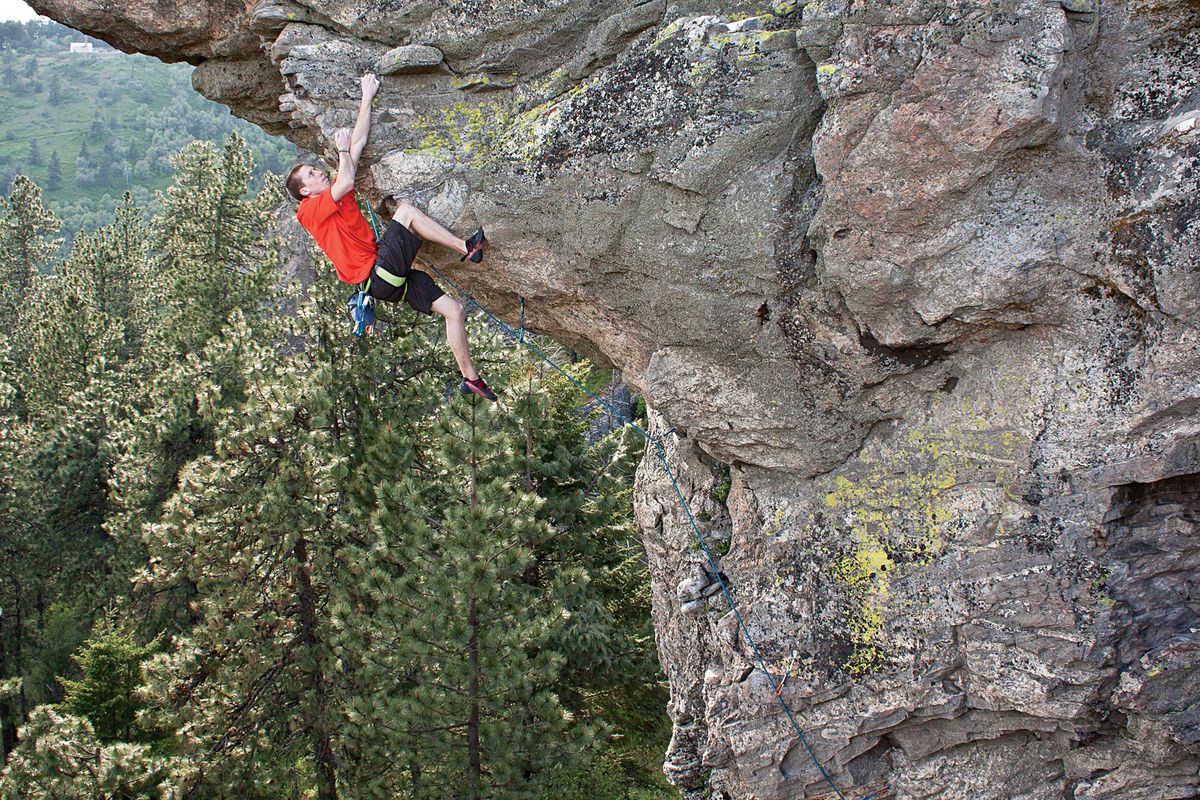Climbers get rise out of Rocks of Sharon

Climbers have been quietly honing their skills on the Rocks of Sharon south of Spokane Valley for more than 60 years. Now they’re going public. Thanks to the Dishman Hills Conservancy, Spokane County and other benefactors, climbers as well as hikers are coming and going freely on land that was private property until just three years ago.
Even though the land had been purchased by DHC and transferred to Spokane County this spring, a parking lot completed in August was the long-awaited key to formally sharing the poorly kept secret about this climbing Shangri-La.
Four local climbers recently published “Climbing the Rocks of Sharon,” a booklet detailing route information and ratings for 70 climbs.
Profits from the $9.95 guide – about $8 a copy – will go to the DHC as a thank you for the group’s conservation legacy, said Paul Fish, owner of Mountain Gear. Fish agreed to help publish and sell the guide for the climbers in his store and online. So far, the guide also is available at Wild Walls.
The first comprehensive guide to the Rocks of Sharon includes “dozens of moderates, several noteworthy test-pieces, as well as the classic climbs first established by notable Spokane Mountaineers back in the 1960s,” said co-author Jon Jonckers.
The area offers the only multi-pitch climbing in Spokane County, he said.
The DHC paved the way for climbers as well as the hikers, birdwatchers, families and other muscle-powered recreationalists heading out on miles of trails.
In 2009, after more than three years of negotiations, the local nonprofit conservation group acquired the 80-acre Rocks of Sharon area in the Spokane Valley near Tower Mountain. The land was acquired this spring by the Spokane County Conservation Futures Program as a south-end addition to the Iller Creek Conservation Area.
The DHC donated $108,000 back to Spokane County Parks to help build the parking area.
The DHC has been active in land preservation and public access since 1966, when it was founded to preserve the Dishman Hills Natural Area to the north.
The Rocks of Sharon were named for the former Sharon stop on a long-abandoned railroad line. Picnickers regularly rode the train to this area in the early 1900s to enjoy the lofty views toward Steptoe Butte and Palouse farm fields.
The centerpiece of the Rocks of Sharon acquisition is a 10-story granite-quartzite monolith known as Big Rock, which towers out of a ridgeline studded with other rock outcroppings.
Eric Barrett, co-author of the new climbing guide, is well-acquainted with these climbing magnets.
“I was immediately attracted to the area’s rock climbing when I moved to Spokane 10 years ago,” Barrett said. “It’s close to my home on the South Hill, and it was well-known to local climbers even though it was private land.”
Barrett became so enamored with the Rocks of Sharon, he set a goal to climb there at least once a month, a vow he’s kept so far for 82 consecutive months.
Aaron Henson, another co-author of the climbing guide, applied his talents as an Avista engineer to help solve the parking problem that thwarted legal public access.
He convinced Avista officials to donate some of his company time so he could assist with planning the parking area, which is designed for handling buses so schools can take advantage of the natural area.
“I’ve enjoyed climbing here for years,” he said during a tour of the site before it was built. “This is a way to give back.”
The Access Fund, a group founded in 1991 to conserve climbing environments and keep them open to the public, also donated to the cause, Fish said.
Big Rock – which towers 230 feet above the ground to an altitude of 3,576 feet overlooking the Palouse – is the dominant attraction as you approach the area from the Stevens Creek Road access. “After doing most rock climbs in this area, you walk off the back side,” Barrett said. “But Big Rock offers a unique summit experience for this area where you have to rappel off.”
The climbing guide also leads rock jocks of all levels to routes on the other Rocks of Sharon features.
The Rookie Wall, for example, is a tongue-in-cheek name for rock routes even Barrett says are beyond his abilities. “The young sport climbers love it,” he said.
Some of Rocks of Sharon routes were published in 2001 in “Inland Northwest Rock Climbs” by Marty Bland.
But the new locally produced 40-page booklet is the first comprehensive guide to the area’s routes graded in difficulty from 5.4 to 5.12. “There’s something there for climbers of all levels,” Barrett said.
The routes have been well-prepped for a new surge of climbers ushered in by the public access.
“There are anchors at the top of most of the routes and rappel anchors off summits you can’t walk off,” Barrett said.
“We’re proud to be a part of this nonprofit venture, and giving back to the Dishman Hills Conservancy and the people who worked so hard to make this place available to everyone.”